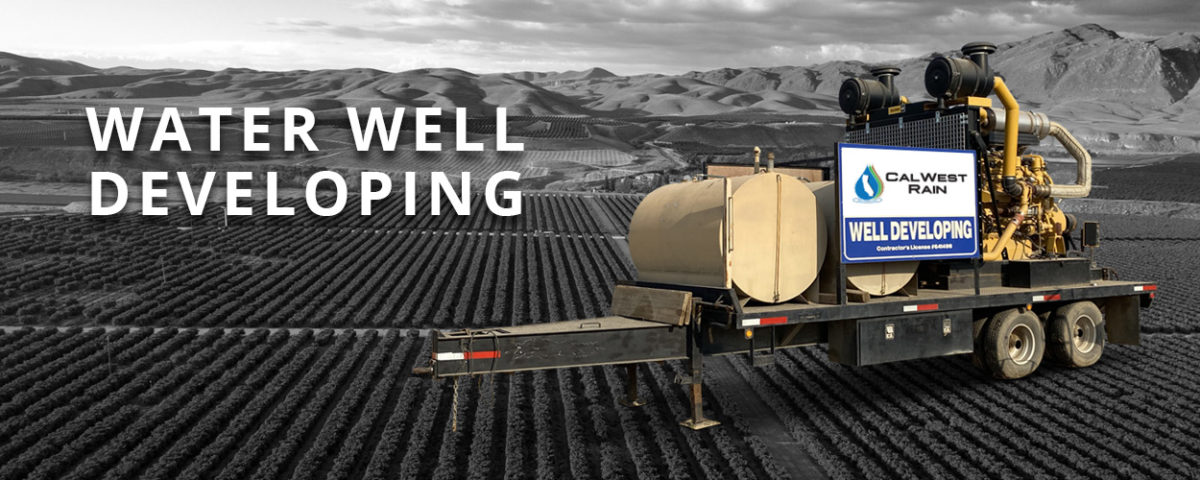With over 50 years experience, we get asked a lot of questions about well development and why it’s a good idea for most new water wells. Proper well design and good well development go hand-in-hand and should result in lower pumping costs, longer pump life, and fewer biological problems such as iron-bacteria and slime build-up.
Conversely, poorly designed and underdeveloped wells are often subject to higher pumping costs and more frequent pump failures because sand enters the well and causes significantly more wear and tear on the bowls. In order to ensure the best results, using an experienced well drilling professional, consulting engineer or geologist, and well development/pump company are strongly recommended for optimal results.
The Well Development Process
Once the drilling company has completed their work including the installation of the well screen, well casing, and gravel pack, it’s recommended that the well is developed to clean the borehole and casing of drilling fluid, fine sediments, foreign material and to properly settle the gravel pack around the well screen.
The typical method for well development is a start/stop surging process to completely clear the well, screen openings, and perforations to ensure unrestricted water flow. This procedure may take several days or longer, depending on the size and depth of the well. A properly developed gravel pack keeps fine sediments out of the well and provides a clean and unrestricted flow. Depending on the well location and circumstances, chemicals/acids (sometimes referred to as “mud thinning agents”) may be used as part of the well cleaning process, in combination with the start/stop surging of the well.
Underdeveloped wells have deeper pumping levels and less production than do properly developed wells, an effect referred to as poor well efficiency. Poor well efficiency occurs when water cannot easily enter the well screen or perforations because of a lack of open area in the screen or perforations, a clogged gravel pack, bacterial slime build-up, or a borehole wall that is clogged from incomplete removal of drilling mud deposits. The result is a significant increase in pumping costs. Note that well efficiency should not be confused with pump efficiency. The latter is related to the selection of a properly sized pump, given the site-specific pump lift requirements and the desired pumping rate (i.e. gpm or gallons per minute).
Pump Tests and Specific Capacity
Once the well is cleaned during the initial phase of the well development process, it’s ready for conducting the pump tests (or aquifer tests) to determine the well’s Specific Capacity. For the pump test, the well is pumped at various stepped rates or a constant rate, typically for 1 to 7 days, while the water levels in the well are checked and recorded frequently as they decline from their standing water level to their pumping water level. When performed by experienced well development professionals, the data from the pump tests is used for several important purposes:
- Plot a site-specific well curve (map flows and drawdown levels) during operation
- Determine the HP required for the desired flow rate (gpm)
- Size the pump bowls for the most efficient operation at the desired flow rate
- Specify the pump/motor package for optimal efficiency to achieve desired flow
- Estimate the cost per acre foot of water at the desired flow rate
Formula for Well Specific Capacity (SC): SC = Q/s
SC = Specific Capacity (gpm/ft); Q = Discharge (gpm); s = Drawdown (ft)
Drawdown = Static/Standing Water Level (ft) – Pumping Water Level (ft)
Generally, the pump test data is used to help determine the efficiency and capacity of the well and to provide information about the permeability of the aquifer. The information about the pumping rate and resulting pumping water levels are critical to properly size the pump for maximum efficiency and years of lower pumping costs.
Once the well development equipment is removed from the well, in some cases it may be useful to use a specialized video camera to check the inside of the well for damage, to verify construction details, and to make sure that all the screen perforations are open for efficient operation.
Finally, the specified pump/motor package are installed and a final system test is performed to ensure it’s ready for years of efficient operation and lower pumping costs.
About Cal-West Rain
With over 50 years of experience in well development, Cal-West Rain has three custom well development rigs and the capacity of up to 1200 horsepower. This means we can handle almost any well development project in Central California.
Cal-West Rain offers expertise in all types of low volume irrigation systems whether they’re under trees, vines, or row crops. From tape systems to drip, micro, and frost control sprinkler systems, we design, install, and service them all! Looking for a local pump expert? Look no further! Cal-West Rain also provides pumps and pump repairs, installation, maintenance, and rebuilds. We can also handle your deep well and booster pump applications, including VFD’s. To learn more, contact Cal-West Rain, Central California’s leader in ag-related irrigation and pump systems since 1989.

